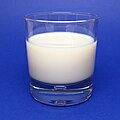Light taste
As a light taste that is off-flavor of foods referred, that alone by the action of sunlight arises. The taste of light is caused by different, but always strongly smelling, chemical compounds .
The light taste in beer has been known and well researched since 1875 . As we know today, he appears alone in beers mixed with hops . The off-flavor arises from the hop bitter substances humulone (= α-acids) found in these beers . Iso-alpha acids are formed from these during wort boiling , which have a higher solubility and a more intense bitterness than α-acids in wort. When exposed to light, an aliphatic side group of the isohumulones is split off and reacts with sulfur-containing seasoning ingredients to form 3-methyl-2-buten-1-thiol . This compound has a very low taste threshold (~ 7 ng / l) and if this concentration is exceeded it can cause an off-taste that is described as rancid.
It is true that the light taste of beer is easy to determine even for laypeople. However, the amount of substance involved in chemical reactions is extremely small and reliable chemical laboratory evidence was only achieved in the 1990s.
In milk , the light taste arises from the Strecker breakdown of the sulfur-containing amino acid methionine . This reacts with the participation of riboflavin as a photosensitizer to methional (methylmercapto-propionaldehyde).
The taste of light is also known with wine and champagne ; one speaks here of cheese .
A simple and efficient protection against the formation of the undesirable light taste is packaging in opaque materials, for drinks in dark bottles. The addition of vanadium pentoxide to the glass melt is still relatively new . This also makes white glass bottles impermeable to UV radiation , which prevents the formation of off-flavors.



